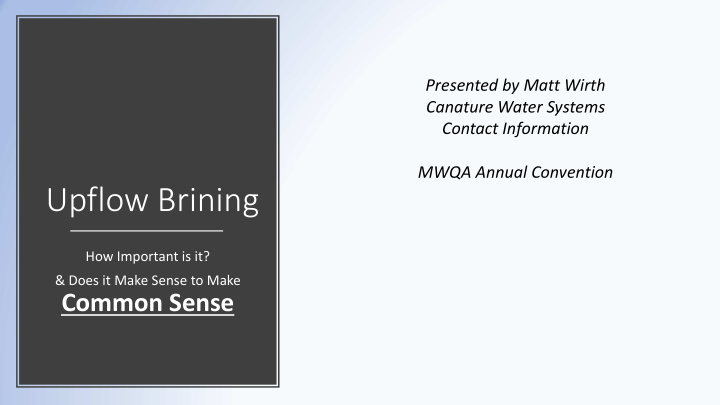



Presented by Matt Wirth Canature Water Systems Contact Information MWQA Annual Convention Upflow Brining How Important is it? & Does it Make Sense to Make Common Sense
Th This is educatio ional l off fferin ing is is recogniz ized by the Mi Minnes esota Depa epartm tmen ent t of Labor and Industr try as as sati atisfyi ying ng 1 1 techni hnical al cre redi dit t toward ard Water Co Conditioning and Plumbing co continuing education requirements.
Brining Backwards? Are we really brining backward, or should Upflow Brining be the “best practice” for regenerating a water softener? If Upflow offers better efficiency and reduced leakage, then why are a majority of water softener controls configured in Downflow? What is right and what is wrong – or, is there a right and wrong? Let us explore that question?
This to Consider… • Fact: IEx resin will regenerate with a correct solution of NaCl in salt brine whether it is introduced into the top of the resin bed or the bottom. • As a rule, upflow brining offers better efficiency in terms of salt use and water waste. It offers more “throughput” per pound of NaCl. • A resin bed regenerated in an upflow pattern will produce water lower in ion leakage longer into the service run. It has a better quality “effluent.” • Upflow brining requires more liquid engineering – it is more complex then downflow.
Why Do/Did They Downflow Brine? • It is Easier – • There is no chance of the bed stratifying. • The injector nozzle is larger and less likely to plug as quickly in severe water. • Note: If a nozzle can plug, it will eventually plug… • It requires less configuration of the valve’s internals. • Who cared? • In the past salt was cheap. • Water Dealers sell salt. • No one paid attention to chloride discharge. They DO now!
+ A Pound of Salt 1 U.S. gallon of 100% @ 60 ° F (15° C) saturated brine contains 2.647 lbs. of salt. The industry uses 3 lbs/gallon of water – remember, a gallon of water with 3 pounds of salts is no longer a gallon. It’ s closer to 2.986 lbs/gal to be exact. 1 Pound of NaCl contains 5,994 grains of Na as CaCO3 1 Pound of KCl contains 4,699 grains of K as CaCO3 Sodium Chloride (Salt) Brine Tables for Brine at 60 F (15 ° C) in US Gallons At 100 degrees brine is fully saturated and contains 26.395 % of salt. 1 US gallon of water weighs 8.33 lbs, 1 US gallon = 3.8 liters = 3.8 kilograms, 1 pound =.453kg, 1kg = 2.2 lbs.
R means it is currently on the resin Mass Transfer of Ions Rabah (2010) In what instance would it make sense to increase the solids loading of a discharge zone by sending 30-50% more high-solids waste to drain when we have the ability to only send 17%?
Being Responsible with Chlorides • What we take out and put back should be a net positive. • We know from The Battelle Report (2009): • Knowing our mass transfer of Na for hardness is basically a net zero effect, it is responsible to minimize the high-solids water going to drain to keep the our benefits on the positive side of net impact.
Bad Efficiency - If 10 lbs of salt has 59,940 grains, then why do we only get 30,000 grains of capacity? - Nearly half of the salt goes down the drain. Bad science ladies & gentlemen!
More Does Not Always Mean Better
Old Fashion In downflow brining, we loose approx. 18% of our • brine just from dilution in the freeboard and the size of the downflow injectors. Michaud C. (2002) Leakage is always an issue in downflow regeneration. • Downflow washes all the hardness & other debris • thru the clean portion of the bed - requiring it to be re-regenerated.
Upflow No dilution • Smaller injectors • Less leakage • Higher salt conversion • Less chloride discharge •
Upflow Precision Brining Brine passes past the clean • part of the bed. Only the used portion of the • bed gets regenerated. Leakage is minimized because • the water passes the best part of the bed last.
Upflow Precision Savings Independent research shows an increased capacity of • approximately 8-10%. CWG R&D shows a 12% SAVINGS IN UPFLOW VS DOWNFLOW. • Leakages are a fraction (usually 1/10th) of downflow • regeneration, which will lengthen the capacity run. Michaud C. (2002) 15-30% reduction in brine used for re-regenerating the • unused portion of the bed.
What This Really Means? We can look seriously at the 3 to 6 lb. salt dose and achieve brine efficiencies of 5,000 to 4,200 grs/lb. of salt while maintaining an overall capacity of nearly 15,000 and 25,000 grains The 3 pound dosage is enough capacity to handle a three-day supply of 20 gr/gal water for the average three-person family while cutting the total brine discharge by half.
Good Efficiency Between Downflow and Upflow, we can cut salt use and chloride discharge by 80% over conventional machines and 27% - 42% over downflow efficiency settings of 6 lbs./cu. ft. Now that’s sound science and eloquent engineering!!!
End User Notes: • Upflow systems take longer to regenerate because the cycle flows are considerably less – this does not mean the use more water, they use longer contact times to get maximum efficiency from the brine. • To maximize the systems capacity, these machines have a 15 minute re-fresh cycle incase for any reason the system needs extra capacity to make it to the scheduled regeneration time – you may hear the machine running at a different time due to this feature. • Do not be surprised at the lack of salt use. If the water is soft, everything is fine.
Matt Wirth Canature Water Group Contact Information Thoughts – Questions?
Recommend
More recommend